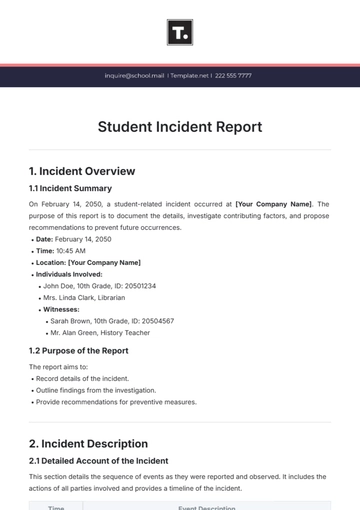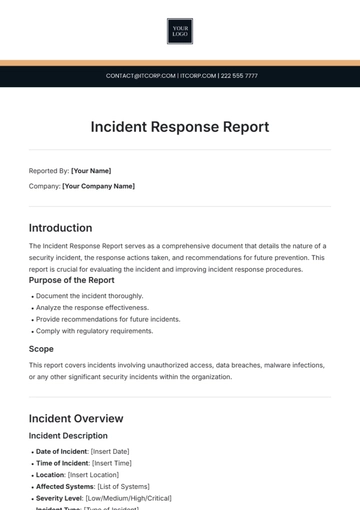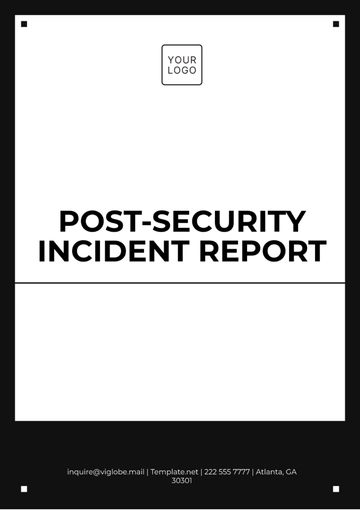Free Environmental Incident Report

I. Incident Overview
Reported By: | [Your Name] |
Email: | [Your Email] |
Date of Incident: | May 18, 2050 |
Time of Incident: | 10:00 AM |
Location of Incident: | [Location of Incident] |
Incident Description: A defective valve during routine maintenance caused a chemical spill at a storage facility, releasing toxic substances that led to evacuations due to strong odors and soil discoloration.
II. Environmental Impact
Immediate Effects: Hazardous chemical spillage contaminated soil and groundwater, extending 100 meters from a storage facility, posing risks to local wildlife and flora, and affecting air quality with harmful vapors impacting respiratory health nearby.
Long-Term Effects: The expected chemical spill could continuously contaminate soil and groundwater, threatening ecosystems, and accumulating toxins in local flora and fauna, which may harm wildlife and pose health risks to humans consuming affected water or food. Corrective actions will be needed for environmental recovery.
III. Causes and Contributing Factors
Primary Cause: The primary cause of the incident was identified as a malfunction in the valve of the chemical storage tank, leading to an uncontrolled release of hazardous chemicals.
Contributing Factors: Factors contributing to the incident involve poor maintenance of the valve system, infrequent inspections, oversight lapses in monitoring protocols, and potentially inadequate training or supervision of maintenance personnel, leading to delayed detection and resolution of the malfunction.
IV. Response and Mitigation Actions
Immediate Actions Taken: Upon discovering the spill, emergency response teams cordoned off the area, initiated cleanup, and evacuated nearby residents and businesses for safety.
Mitigation Measures: Extensive cleanup efforts removed contaminated soil and water, using specialized equipment to neutralize chemicals. Safety protocols were reinforced, and monitoring systems were enhanced to prevent future incidents.
Agencies Notified: The Environmental Protection Agency, the Department of Environmental Conservation, and local emergency authorities were quickly notified to coordinate a response and ensure compliance with all relevant regulations.
V. Follow-Up Actions
Monitoring: Routine and thorough evaluations will be conducted to oversee soil health, groundwater quality, wildlife condition, and air purity, ensuring that the remediation activities are successful and meeting their objectives.
Reporting: Detailed reports will document monitoring results, cleanup progress, and regulatory updates, shared with authorities, stakeholders, and the public for transparency.
Review and Analysis: A thorough investigation will pinpoint the incident's cause, analyzing maintenance records and protocols to implement preventative measures.
VI. Attachments and References
Photos: Attached to this document will be high-resolution images that capture various aspects of the incident, including the initial spill, the ongoing cleanup efforts, and the areas that have been affected, to provide visual documentation of the entire event.
Documents: Incident logs detailing response actions, witness statements, regulatory communications, and any relevant documentation related to the incident will be included as attachments.
References: This report has been prepared with the aim of addressing issues related to environmental regulations, safety protocols, and adherence to company policies.
VII. Incident Conclusion
The incident response efforts effectively contained the spill and mitigated immediate risks to the environment and public safety. Ongoing monitoring and remediation activities will continue to address any residual impacts and ensure the restoration of the affected area. Lessons learned from this incident will inform future preventative measures and improve overall response preparedness.
- 100% Customizable, free editor
- Access 1 Million+ Templates, photo’s & graphics
- Download or share as a template
- Click and replace photos, graphics, text, backgrounds
- Resize, crop, AI write & more
- Access advanced editor
Promote environmental accountability with the Environmental Incident Report Template from Template.net. This customizable and editable template is perfect for recording and evaluating environmental incidents. Editable in our Ai Editor Tool, it simplifies the documentation process, enabling you to create thorough and professional reports that adhere to environmental regulations and standards.
You may also like
- Sales Report
- Daily Report
- Project Report
- Business Report
- Weekly Report
- Incident Report
- Annual Report
- Report Layout
- Report Design
- Progress Report
- Marketing Report
- Company Report
- Monthly Report
- Audit Report
- Status Report
- School Report
- Reports Hr
- Management Report
- Project Status Report
- Handover Report
- Health And Safety Report
- Restaurant Report
- Construction Report
- Research Report
- Evaluation Report
- Investigation Report
- Employee Report
- Advertising Report
- Weekly Status Report
- Project Management Report
- Finance Report
- Service Report
- Technical Report
- Meeting Report
- Quarterly Report
- Inspection Report
- Medical Report
- Test Report
- Summary Report
- Inventory Report
- Valuation Report
- Operations Report
- Payroll Report
- Training Report
- Job Report
- Case Report
- Performance Report
- Board Report
- Internal Audit Report
- Student Report
- Monthly Management Report
- Small Business Report
- Accident Report
- Call Center Report
- Activity Report
- IT and Software Report
- Internship Report
- Visit Report
- Product Report
- Book Report
- Property Report
- Recruitment Report
- University Report
- Event Report
- SEO Report
- Conference Report
- Narrative Report
- Nursing Home Report
- Preschool Report
- Call Report
- Customer Report
- Employee Incident Report
- Accomplishment Report
- Social Media Report
- Work From Home Report
- Security Report
- Damage Report
- Quality Report
- Internal Report
- Nurse Report
- Real Estate Report
- Hotel Report
- Equipment Report
- Credit Report
- Field Report
- Non Profit Report
- Maintenance Report
- News Report
- Survey Report
- Executive Report
- Law Firm Report
- Advertising Agency Report
- Interior Design Report
- Travel Agency Report
- Stock Report
- Salon Report
- Bug Report
- Workplace Report
- Action Report
- Investor Report
- Cleaning Services Report
- Consulting Report
- Freelancer Report
- Site Visit Report
- Trip Report
- Classroom Observation Report
- Vehicle Report
- Final Report
- Software Report





























